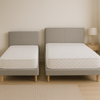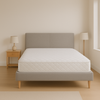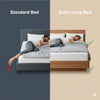What Your Mattress Says About Your Sleep Habits
- by Giorgi Gogidze

Your mattress reveals significant insights about your sleep patterns, comfort preferences, and overall health habits. From wear patterns that indicate your favorite sleeping position to the firmness level that reflects your body weight and comfort needs, your mattress serves as a physical record of how you sleep, how often you move, and what prioritizes your rest quality.
[toc]
Key Mattress Insights About Your Sleep Habits
- Body impressions: Deep indentations show you sleep in the same position nightly and may indicate poor spinal alignment
- Edge wear: Damaged mattress edges suggest you sit on your bed frequently or sleep close to the edge
- Overall sagging: Indicates either an old mattress, poor quality, or significantly heavy usage over time
- Stains and odors: Reveal poor sleep hygiene, night sweats, or inadequate mattress protection
- Firmness choice: Reflects your body weight, sleep position preferences, and comfort priorities
- Size selection: Shows whether you prioritize personal space, share your bed, or have space constraints
Understanding What Your Mattress Reveals About Your Sleep Habits
Your mattress functions as a silent observer of your nightly routines, recording evidence of your sleep patterns, preferences, and habits through physical wear and your purchasing decisions. Like a detective examining clues, understanding these signs can provide valuable insights into your sleep quality and overall health approach.
The relationship between mattress condition and sleep habits extends beyond simple comfort. Your mattress choice and its current state reflect conscious and unconscious decisions about sleep prioritization, body awareness, and long-term health considerations. These insights can help identify areas for improvement in your sleep environment and habits.
Decoding Sleep Position Patterns
The wear patterns on your mattress tell a detailed story about how you sleep. Body impressions or permanent indentations typically form where you spend the most time, revealing your preferred sleep position and whether you move frequently during the night. Side sleepers often create deeper impressions on one side of the mattress, while back sleepers may show more even wear across the center.
Couples can observe interesting patterns that reveal their sleeping compatibility and habits. Separate body impressions suggest minimal movement toward each other during sleep, while a large central depression might indicate frequent cuddling or one partner gravitating toward the middle. Uneven wear between sides often shows different sleep schedules or one partner spending more time in bed.
Firmness Preferences and Personal Characteristics
Your mattress firmness choice reveals significant information about your body awareness and comfort priorities. People who choose firm mattresses often prioritize spinal alignment and may be back or stomach sleepers, have higher body weight, or experience back pain. These individuals typically value support over pressure relief and may have a more structured approach to health and wellness.
Soft mattress preferences usually indicate side sleeping habits, lower body weight, or prioritizing pressure point relief over firm support. These sleepers often value immediate comfort and may be more sensitive to pressure. Medium-firm choices suggest adaptability and possibly shared sleeping arrangements where compromise is necessary.
Age and Maintenance Revealing Sleep Hygiene
The age and condition of your mattress speaks volumes about your sleep hygiene and health priorities. A well-maintained older mattress suggests good sleep habits, including regular cleaning, proper protection, and awareness of sleep environment importance. Conversely, a prematurely worn mattress might indicate neglect of sleep health or lack of awareness about mattress care.
Stains, odors, or excessive wear on a relatively new mattress can reveal several concerning habits. Night sweats, eating in bed, poor ventilation, or lack of mattress protection all leave telltale signs. These indicators often correlate with broader health and hygiene habits that extend beyond sleep.
Temperature Regulation and Material Choices
Your mattress material selection reveals your body's temperature regulation patterns and environmental preferences. Memory foam enthusiasts typically sleep colder or prioritize pressure relief over temperature control. Innerspring or hybrid mattress users often sleep warmer or value bounce and responsiveness over contouring.
Cooling gel layers, breathable covers, or natural materials like latex suggest you're a warm sleeper who prioritizes temperature regulation. These choices indicate awareness of how temperature affects sleep quality and willingness to invest in solutions for better rest.
Size Selection and Lifestyle Insights
Mattress size choices reflect lifestyle priorities and sleeping arrangements. King or California king mattresses suggest prioritizing personal space, having sleeping partners, pets, or children who share the bed, or simply having the financial resources and bedroom space for larger furniture.
Twin or full-size mattresses in adult bedrooms might indicate space constraints, budget considerations, single sleeping arrangements, or minimal time spent in the bedroom. Queen sizes often represent practical compromises between space and cost considerations.
Red Flags and Health Implications
Certain mattress conditions can reveal concerning sleep or health habits. Excessive sagging may indicate sleeping in the same position due to pain or mobility issues. Unusual wear patterns might suggest restless sleep, frequent position changes due to discomfort, or underlying sleep disorders.
Poor mattress condition despite recent purchase could indicate night sweats from hormonal changes, medications, or health conditions. Asymmetrical wear patterns in shared beds might reveal sleep schedule differences, relationship issues, or one partner experiencing sleep disturbances.
Using Mattress Insights for Better Sleep
Understanding what your mattress reveals can guide improvements in your sleep environment and habits. If body impressions show you're not moving enough during sleep, consider whether your mattress provides adequate support for position changes. Premature wear might indicate the need for better mattress protection or evaluation of your sleep environment.
Temperature-related wear or discomfort signs suggest investigating bedroom climate control, sleepwear choices, or mattress materials. Poor edge support wear indicates the need for a higher-quality mattress or changes in bedroom furniture arrangement to reduce sitting on the bed edges.
By treating your mattress as a diagnostic tool, you can identify specific areas for improvement in your sleep habits, environment, and overall approach to rest and recovery.




